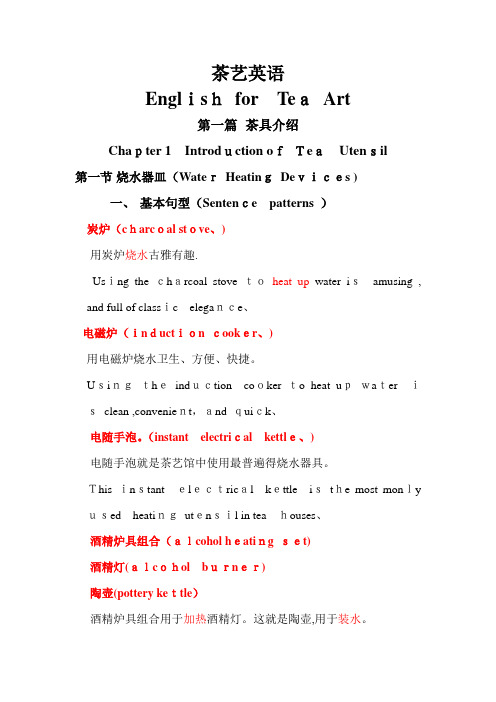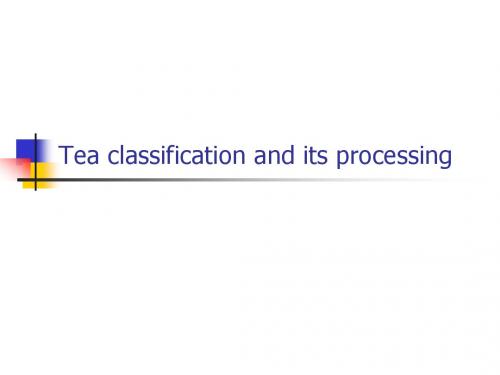tea classification
- 格式:ppt
- 大小:296.50 KB
- 文档页数:20


茶艺英语Englishfor TeaArt第一篇茶具介绍Chapter 1Introduction ofTeaUtensil第一节烧水器皿(WaterHeatingDevices )一、基本句型(Sentence patterns )炭炉(charcoal stove、)用炭炉烧水古雅有趣.Using the charcoal stove toheat up water isamusing , and full of classic elegance、电磁炉(induction cooker、)用电磁炉烧水卫生、方便、快捷。
Usingtheinduction cooker to heat upwaterisclean ,convenient,and quick、电随手泡。
(instant electrical kettle、)电随手泡就是茶艺馆中使用最普遍得烧水器具。
This instantelectrical kettle isthe most monly used heatingutensil in teahouses、酒精炉具组合(alcohol heating set)酒精灯(alcohol burner)陶壶(pottery kettle)酒精炉具组合用于加热酒精灯。
这就是陶壶,用于装水。
alcohol heating set has a alcohol burner,using for heatingupwater,andapottery kettle,used as the water container、酒精炉具组合美观、方便,使用于茶艺表演.Thealcohol heating set is pleasing to the eye and easytouse ,and thus issuitable for tea ceremony performance、玻璃煮水器组合(glass heaterset )玻璃器皿晶莹剔透,便于观察其中汤色得变化,最适合用于煮黑茶、普洱茶、奶茶。



一、制茶Making Tea1 tea bush 茶树2 tea harvesting 采青3 tea leaves 茶青4 withering 萎凋sun withering 日光萎凋indoor withering 室内萎凋setting 静置tossing 搅拌(浪青5 fermentation 发酵 6 oxidation 氧化7 fixation 杀青steaming 蒸青stir fixation炒青baking 烘青sunning 晒青8 rolling 揉捻light rolling 轻揉heavy rolling 重揉cloth rolling 布揉9 drying 干燥pan firing 炒干baking 烘干sunning 晒干10 piling 渥堆11 refining 精制screening 筛分cutting 剪切de-stemming 把梗shaping 整形winnowing 风选blending 拼配compressing 紧压re-drying覆火aging 陈放12 added process 加工roasting 焙火scenting 熏花spicing调味tea beverage 茶饮料13 Packing包装vacuum packaging 真空包装nitrogen packs 充氮包装shredded-tea bag 碎形小袋茶leave-tea bag 原片小袋茶其它1、焙火roastingotte 生茶Half-baked 半熟Well-done 熟茶2、Shelf Life 保质期3、Effect 功效health tea保健茶slimming tea减肥茶organic tea有机茶4、Form Style 形态类别Compressed tea 紧压茶砖Brick tea 茶砖Loose tea 散茶5、Packaging 包装Bag 袋Box 箱Gift packing 礼品包装Vacuum pack 真空包装Bottle 瓶Cup 杯Mason jar 玻璃杯Bulk 大容量二、分类ClassificationAccording to the degree of fermentation, rolling, baking and tea leaf maturity.根据制造时发酵,揉捻焙火与采摘时原料成熟度来分类。

茶叶专业英语一、制茶Making T ea1 tea bush 茶树2 tea harvesting 采青3 tea leaves 茶青4 withering 萎凋sun withering 日光萎凋indoor withering 室内萎凋setting 静置tossing 搅拌(浪青5 fermentation 发酵 6 oxidation 氧化7 fixation 杀青steaming 蒸青stir fixation炒青baking 烘青sunning 晒青8 rolling 揉捻light rolling 轻揉heavy rolling 重揉cloth rolling 布揉9 drying 干燥pan firing 炒干baking 烘干sunning 晒干10 piling 渥堆11 refining 精制screening 筛分cutting 剪切de-stemming 把梗shaping 整形winnowing 风选blending 拼配compressing 紧压re-drying覆火aging 陈放12 added process 加工roasting 焙火scenting 熏花spicing调味tea beverage 茶饮料13 Packing包装vacuum packaging 真空包装nitrogen packs 充氮包装shredded-tea bag 碎形小袋茶leave-tea bag 原片小袋茶其它1、焙火roastingotte 生茶Half-baked 半熟Well-done 熟茶2、Shelf Life 保质期3、Effect 功效health tea保健茶slimming tea减肥茶organic tea有机茶4、Form Style 形态类别Compressed tea 紧压茶砖Brick tea 茶砖Loose tea 散茶5、Packaging 包装Bag 袋Box 箱Gift packing 礼品包装Vacuum pack 真空包装Bottle 瓶Cup 杯Mason jar 玻璃杯Bulk 大容量二、分类ClassificationAccording to the degree of fermentation, rolling, baking and tea leaf maturity.根据制造时发酵,揉捻焙火与采摘时原料成熟度来分类。
茶学专业名词英文比照通过整理的茶学专业名词英文比照相关文档,渴望对大家有所扶植,感谢观看!各类茶叶品种中英文单词翻译比照茶:tea绿茶:green tea红茶:black tea白茶:white tea花茶:scented tea普洱茶:Pu \'er tea;Pu Erh tea;Puu Eel tea 黄茶:yellow tea 黑茶:dark tea 新茶:sincha雨前茶:Yu-chie n tea袋泡茶:teabag大麦茶:Mugi-cha花草茶:Herbal tea茉莉花茶:Jasmine tea 菊花茶:Chrysanthemum tea 普洱(砖):Block Puerh tea 陈年普洱:Aged Pu \'er Tea 乌龙茶:Oolong Tea;Oulung Tea武夷茶:Bohea Tea熙春茶:Hyson Tea功夫茶:Congou Tea;Gongou Tea屯溪茶:Twankay Tea祁门茶:Keemun Tea龙井茶:Lou ngjing tea ; Longjing tea ; Lu ng Chi ng tea ; Dragon Well Tea 注:“Dragon Well ”是对龙井"这一名词的非正规翻译,不建议运用。
铁观音:Tieh-Kuan-Yin;TieGuanYin Tea云雾茶:Cloud mist白毫:Pekoe 注:该单词又指印度,斯里兰卡的高级红茶。
牛舌:Cowslip高末儿:Gunpowder绿茶油:Camellia Oleifera茶匙:teaspoon茶馆:teahouse茶壶:teapot茶具:tea set;tea service茶漏:tea strainer茶点:tea biscuit 注:tea cake 是指西人茶后餐点,不是指中国的配茶小点。
茶盘:tea tray;teaboard茶罐:tea canister;caddy紫砂:purple granulated;purple sand;terra-cotta紫砂壶:purple clay teapot;purple sand teapot茶油:tea oil茶籽油:teaseed oil茶道:sado;茶道:sado;tea-making注:“茶道”一词来自日语,所以英语接受了日语的音译“sado”还有人将茶道译作“tea way;明显很不正规。
Grade Level: Primary SchoolSubject: Science / Social StudiesDuration: 1 hourObjective:1. To introduce students to the basic types of tea and their characteristics.2. To enhance students' ability to classify and categorize items.3. To foster an interest in different cultures and their traditions.Materials:- A variety of tea samples (black, green, white, oolong, and herbal)- Pictures or illustrations of each type of tea- Small cups or containers for each tea sample- Worksheets for classification activity- Projector or smartboard for presentations- Interactive whiteboard or blackboard for group activities- Tea bags (optional for tasting)Lesson Outline:I. Introduction (10 minutes)- Begin the lesson by asking students what they know about tea. Encourage them to share their experiences and knowledge.- Introduce the concept of tea classification and its importance in understanding different cultures and their traditions.II. Presentation (15 minutes)- Use a projector or smartboard to display pictures or illustrations of different types of tea.- Briefly explain the origin, characteristics, and preparation methods of each type of tea:- Black Tea: Originating from China, black tea is fully oxidized. It has a strong flavor and is commonly used in the morning.- Green Tea: Also from China, green tea is not oxidized. It has a light, grassy taste and is often consumed for its health benefits.- White Tea: White tea is the least processed of all teas. It has a delicate flavor and is known for its high antioxidant content.- Oolong Tea: A semi-oxidized tea from China, oolong tea has a unique flavor that combines the best of green and black teas.- Herbal Tea: Not a true tea, herbal teas are made from the leaves of plants other than the tea plant. They have a wide range of flavors and health benefits.III. Interactive Activity (20 minutes)- Divide the class into small groups.- Provide each group with a worksheet containing pictures of tea samples and spaces to classify them.- Instruct students to work together to identify and categorize the teas based on their characteristics.- Encourage students to discuss and share their findings with the class.IV. Group Discussion (10 minutes)- Bring the class back together and ask each group to present their findings.- Discuss the differences between the various types of tea and their cultural significance.- Ask students to explain how tea is used in different cultures, such as in Chinese tea ceremonies or British afternoon tea.V. hands-on Activity (10 minutes)- If available, offer students the opportunity to taste different types of tea.- Explain the proper way to taste tea and the importance of sipping slowly to appreciate the flavors.- After tasting, ask students to discuss their preferences and the flavors they experienced.VI. Conclusion (5 minutes)- Summarize the main points of the lesson, emphasizing the diversity of tea types and their cultural importance.- Encourage students to continue exploring the world of tea and its rich history.Assessment:- Observe students' participation in the interactive activity and their ability to classify the teas correctly.- Evaluate the quality of their group presentations and discussions.- Assess their engagement during the tasting activity and their ability to articulate their preferences.Follow-up Activities:- Assign a research project for students to explore the tea culture of a specific country.- Organize a school-wide tea party where students can share their knowledge and experiences with their families and friends.。
3.3Tea classificationHello,welcome to our course of Chinese culture.大家好,欢迎来中国文化概要课程。
In this section,please join us to find out more about the classification of Chinese tea.这一节,请和我们一起来学习中国茶的分类。
China has a rich and sophisticated tea culture.中国茶文化源远流长,博大精深。
There is a common saying in China,中国有句俗话:“seven things in the house:firewood,rice,oil,salt,soy sauce,vinegar and tea”.“开门七件事:柴、米、油、盐、酱、醋、茶。
”From this saying,we know that tea plays an important role in Chinese people’s daily life.从这句话,我们知道茶在中国人的日常生活中的重要地位。
China is universally acknowledged the first country to grow,produce and drink tea.中国是全世界公认的最早种植茶叶,生产茶叶,和饮茶的国家。
Through the ancient silk road,it was introduced to western Asia and Europe.经过古代丝绸之路,中国的茶叶种植、生产技术和饮茶的风俗逐渐传入西亚和欧洲。
British people like drinking tea very much.英国人也爱喝茶。
They prefer to add milk and sugar in black tea,他们喜欢在红茶中加入牛奶和糖,which is quite different from Chinese tea drinking process.这和中国的饮茶方式大不相同。
一、制茶术语(中英文对照版)1、tea bush茶树2、tea harvesting采青3、tea leaves茶青4、withering萎凋Sun withering日光萎凋indoor withering室内萎凋etting静置tossing 搅拌(浪青)5、fermentation 发酵6、oxidation 氧化7、fixation 杀青Steaming 蒸青stir fixation 炒青baking 烘青sunning 晒青8、rolling揉捻Light rolling 轻揉heavy rolling 重揉cloth rolling 布揉9、drying 干燥Pan firing 炒干baking 烘干sunning 晒干10、piling 渥堆11、refining 精制Screening 筛分cutting 剪切de-stemming 把梗shaping 整形winnowing 风选blending 拼配compressing 紧压re-drying覆火aging 陈放12、added process 加工Roasting 焙火scenting 熏花spicing调味tea beverage 茶饮料13、Packing包装Vacuum packaging真空包装nitrogen packs 充氮包装shredded-tea bag 碎形小袋茶leave-tea bag 原片小袋茶二:茶叶分类相关术语(中英文对照版)classificationAccording to the degree of :fermentation ,rolling, baking and tea leaf maturity根据制造时发酵,揉捻焙火与采摘时原料成熟度来分类Non-fermented不发酵茶,即绿茶Post-fermented后发酵茶即普洱茶Partially fermented部分发酵茶,半发酵茶,即乌龙茶(铁观音)Complete fermentation全发酵茶,即红茶(1)绿茶分类术语(中英文对照版):Steamed green tea蒸青绿茶Powered green tea 粉末绿茶Silver needle green tea 银针绿茶Lightly rubbed green tea 原形绿茶Curled green tea 松卷绿茶Sword shaped green tea剑片绿茶Twisted green tea 条形绿茶Pearled green tea 圆珠绿茶(2)普洱茶分类术语(中英文对照版):Age-puer陈放普洱pile-fermented puer渥堆普洱(3)乌龙茶分类术语(中英文对照版):White oolong白茶乌龙twisted oolong条形乌龙Pelleted oolong 球形乌龙roasted oolong熟火乌龙White tipped oolong白毫乌龙(4)红茶分类术语(中英文对照版):Unshredded black tea功夫红茶shredded black tea:碎形红茶(5)熏花茶分类术语(中英文对照版):Scented green tea熏花绿茶scented puer tea熏花普洱Scented oolong tea 熏花乌龙scented black tea熏花红茶Jasmine scented green tea熏花茉莉上述各类如果假如食品或香料,就成为调味茶(spiced tea),如果加到绿茶,则成为:spiced green tea 调味绿茶,以此类推。